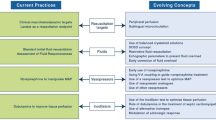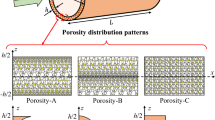Abstract
Purpose
Radial extracorporeal shock wave therapy (rESWT) has been used in clinical and rehabilitation fields. However, the formulation of related clinical treatment protocols and the full potential of its therapeutic efficacy are constrained due to limited understanding of shock wave sources. This study aimed to further clarify the characteristics of shock wave sources generated at different medium interfaces.
Methods
Shock wave generated by rESWT device at the interface of different media (soft tissue-mimicking-phantom, water and air) was measured based on flexible polyvinylidene fluoride (PVDF) sensors. The temporal and spectral characteristics of the shock wave source were analyzed.
Results
The wave generated at the phantom interface was similar to that at the water interface under the same impact pressure, both being largely different from that at the air interface, where the absolute value of the peak pressure was significantly reduced. The spectral properties of the shock wave generated in different media were similar, with distinct peak frequencies, varying modulation frequencies in phantom (12.2 kHz), water (8.5 kHz), and air (7.2 kHz), and a relatively constant carrier frequency (between 82 and 83 kHz). Under the different impact pressures, there were no variations in the peak frequency at the same medium interface, indicating that the impact pressure mainly impacts the shock wave amplitude, but not the peak frequency.
Conclusion
The shock waves generated at different medium interfaces exhibited temporal and spectral differences. Therefore, measurement results in biological soft tissues cannot be simply replaced by the measurement results in air or water. The results of this study are expected to provide important information for evaluating rESWT devices and optimizing clinical shock wave treatment protocols.





Similar content being viewed by others
References
Schmitz, C., Csaszar, N. B., Milz, S., et al. (2015). Efficacy and safety of extracorporeal shock wave therapy for orthopedic conditions: A systematic review on studies listed in the PEDro database. British Medical Bulletin, 116(1), 115–138.
Rompe, J. D., Furia, J., & Maffulli, N. (2009). Eccentric loading versus eccentric loading plus shock-wave treatment for midportion Achilles tendinopathy: A randomized controlled trial. American Journal of Sports Medicine, 37(3), 463–470.
Knobloch, K., & Kraemer, R. (2015). Extracorporeal shock wave therapy (ESWT) for the treatment of cellulite—a current meta-analysis. International Journal of Surgery, 24, 210–217.
Jain, T. K., & Sharma, N. K. (2014). The effectiveness of physiotherapeutic interventions in the treatment of frozen shoulder/adhesive capsulitis: A systematic review. Journal of Back and Musculoskeletal Rehabilitation, 27(3), 247–273.
Zhang, Q., Liu, L., Sun, W., et al. (2017). Extracorporeal shockwave therapy in osteonecrosis of femoral head: A systematic review of now available clinical evidences. Medicine (Baltimore), 96(4), e5897.
Moya, D., Ramón, S., & Schaden, W. (2018). The role of extracorporeal shockwave treatment in musculoskeletal disorders. Journal of Bone and Joint Surgery. American Volume. https://doi.org/10.2106/JBJS.17.00661
Cheng, J. H., & Wang, C. J. (2015). Biological mechanism of shockwave in bone. International Journal of Surgery, 24, 143–146.
Choi, M. J., & Kwon, O. (2021). Temporal and spectral characteristics of the impulsive waves produced by a clinical ballistic shock wave therapy device. Ultrasonics, 110, 106238.
Holfeld, J., Tepekoylu, C., Kozaryn, R., et al. (2014). Shockwave therapy differentially stimulates endothelial cells: Implications on the control of inflammation via toll-like receptor 3. Inflammation, 37(1), 65–70.
Liu, Y., Chen, X. D., Guo, A. Y., et al. (2018). Quantitative assessments of mechanical responses upon radial extracorporeal shock wave therapy. Advanced Science (Weinh), 5(3), 1700797.
Alkhamaali, Z. K., Crocombe, A. D., Solan, M. C., et al. (2016). Finite element modelling of radial shock wave therapy for chronic plantar fasciitis. Computer Methods in Biomechanics and Biomedical Engineering, 19(10), 1069–1078.
Pere, C., Chen, H., & Matula, T. J. (2013). Acoustic field characterization of the Duolith: Measurements and modeling of a clinical shock wave therapy device. Journal of the Acoustic Society of America, 134(2), 1663–1674.
Fagnan KM, LeVeque RJ, Matula TJ, et al. High-resolution finite methods methods for extracorporeal shock wave therapy. Hyperbolic Problems: Theory, Numerics, Applications, 2008: 503-510
Cleveland, R. O., Chitnis, P. V., & McClure, S. R. (2007). Acoustic field of a ballistic shock wave therapy device. Ultrasound in Medicine and Biology, 33(8), 1327–1335.
Rad, A. J., & Ueberle, F. (2012). Pressure Pulse Fields: Comparison of optical hydrophone measurements with FEM simulations. Biomedical Engineering/Biomedizinische Technik. https://doi.org/10.1515/bmt-2012-4466
Rad, A. J., & Ueberle, F. (2015). Field mapping of ballistic pressure pulse sources. Current Directions in Biomedical Engineering, 1(1), 26–29.
Ueberle, F., & Rad, A. J. (2011). Pressure pulse measurements using optical hydrophone principles. Journal of Physics: Conference Series, 279(1), 012003.
Ueberle, F., & Rad, A. J. (2012). Ballistic pain therapy devices: Measurement of pressure pulse parameters. Biomedical Engineering/Biomedizinische Technik. https://doi.org/10.1515/bmt-2012-4439
Ueberle, F., & Rad, A. J. (2015). Unfocused/weakly focused pressure pulse sources for pain therapy: Measurements in water and in a dry test bench. Acta Physica Polonica A, 127, 135–137.
Reinhardt, N., Dick, T., Lang, L., et al. (2021). Hybrid test bench for high repetition rate radial shock wave measurement. Current Directions in Biomedical Engineering, 7, 395–398.
IEC 63045:2020, Ultrasonic—Non-focusing short pressure pulse sources including ballistic pressure pulse sources—Characteristics of fields.
Emamian, S., Narakathu, B. B., Chlaihawi, A. A., et al. (2016). Fabrication and characterization of piezoelectric paper based device for touch and force sensing applications. Procedia Engineering, 168, 688–691.
Benoit, M., Giovanola, J. H., Agbeviade, K., et al. (2009). Experimental Characterization of Pressure Wave Generation and Propagation in Biological Tissues (pp. 1623–1626). Springer.
Sawicki, M., Maćkowski, M., & Płaczek, M. (2022). The phenomenon of loss of energy flux density in pneumatic and electromagnetic generators for EPAT therapy. Applied Sciences, 12, 12939.
Funding
This work was funded by the National Key Research and Development Program of China (Grant 2020YFC0122201), the National Natural Science Foundation of China (Grant 32071315), and the Fundamental Research Funds for the Central Universities (Grant YWF-22-L-1234).
Author information
Authors and Affiliations
Contributions
FF, YF, and HN conceived and designed the study. FF and HN established the protocol. LX, QW and FS performed the experiments. LX, LW and FL helped with data processing. FF and HN wrote the manuscript, and all other authors reviewed and commented on the draft. All authors have read and approved the manuscript.
Corresponding author
Ethics declarations
Conflict of interest
The authors declare that they have no conflicts of interest.
Ethical Approval
This is an observational study. The Beihang University Research Ethics Committee has confirmed that no ethical approval is required.
Additional information
Publisher’s Note
Springer nature remains neutral with regard to jurisdictional claims in published maps and institutional affiliations.
Rights and permissions
Springer Nature or its licensor (e.g. a society or other partner) holds exclusive rights to this article under a publishing agreement with the author(s) or other rightsholder(s); author self-archiving of the accepted manuscript version of this article is solely governed by the terms of such publishing agreement and applicable law.
About this article
Cite this article
Fan, F., Xu, L., Wu, Q. et al. Measurement and Analysis of Impulse Source Produced by Ballistic Shock Wave Therapy Device in Different Medium Using PVDF Sensor. J. Med. Biol. Eng. 44, 35–42 (2024). https://doi.org/10.1007/s40846-024-00845-z
Received:
Accepted:
Published:
Issue Date:
DOI: https://doi.org/10.1007/s40846-024-00845-z




